-
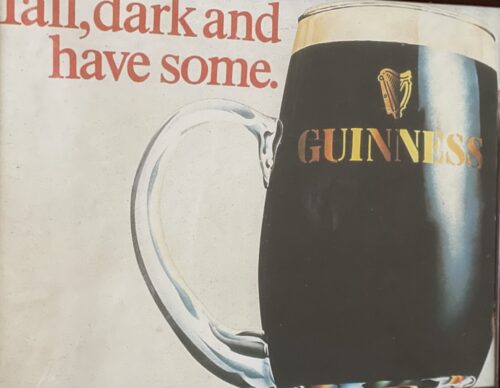
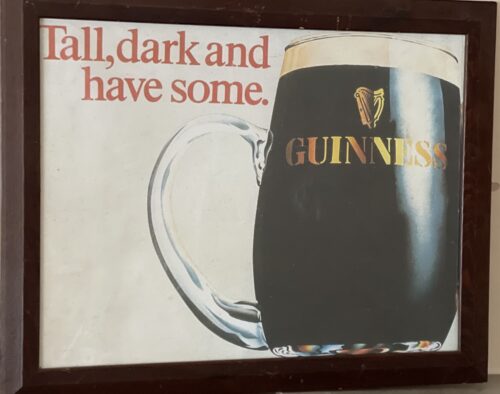 50cm x 65cm Imagination is something Guinness Advertising has never been short of… From John Gilroy’s hapless zookeeper and his menagerie of creatures to a Polynesian surfer and a herd of white horses; from messages in bottles setting sail across the ocean to a single, heart-stoppingly enormous wave. Guinness have been carving out their own creative path for almost a century with decades of extraordinary and enduring print, TV and digital campaigns to their name, and hopefully they will continue to push boundaries to tell stories to the world. Here’s to original thinking !
50cm x 65cm Imagination is something Guinness Advertising has never been short of… From John Gilroy’s hapless zookeeper and his menagerie of creatures to a Polynesian surfer and a herd of white horses; from messages in bottles setting sail across the ocean to a single, heart-stoppingly enormous wave. Guinness have been carving out their own creative path for almost a century with decades of extraordinary and enduring print, TV and digital campaigns to their name, and hopefully they will continue to push boundaries to tell stories to the world. Here’s to original thinking ! -

 32cm x 28cm Originating from an pub in Co Kerry -this innuendo laden election poster will catch the eye in any bar ! Richard Nixon’s mother Hannah was descended from the Milhous family, Irish Quakers from Timahoe, Kildare while the first Nixon to arrive in the US, James, left Ireland in 1731. President Nixon visited the small town in October 1970 during a state visit to Ireland. He is the only US president to date to resign from office following his involvement in the Watergate scandal.
32cm x 28cm Originating from an pub in Co Kerry -this innuendo laden election poster will catch the eye in any bar ! Richard Nixon’s mother Hannah was descended from the Milhous family, Irish Quakers from Timahoe, Kildare while the first Nixon to arrive in the US, James, left Ireland in 1731. President Nixon visited the small town in October 1970 during a state visit to Ireland. He is the only US president to date to resign from office following his involvement in the Watergate scandal. -
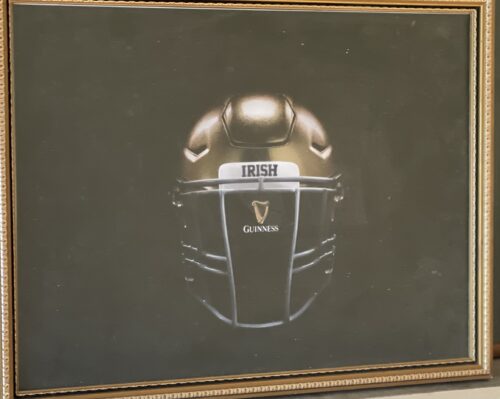
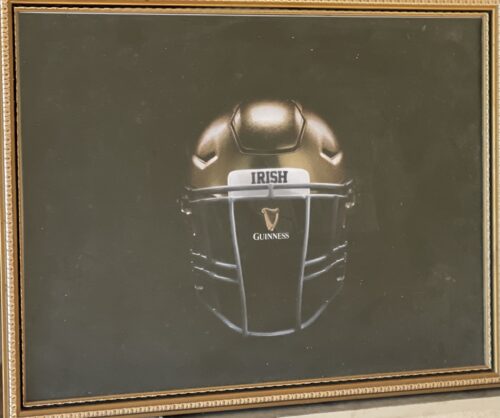 The television commercial created by the famous brewing company will leave you with a smile on your face and maybe a craving for a pint of the black stuff! Former Fighting Irish quarterback Joe Montana features in this Guinness US commercial from 2021, while a cover of the catchy 1999 song "Praise You" plays in the background. On a trip with my family to Ireland, I fell in love with Guinness. A perfect pint is lighter and more delicious than I ever imagined," Montana previously said in an interview. Guinness US is currently running a seven-year collaboration with Notre Dame Fighting Irish, uniting two Irish institutions, and raising a Guinness toast to honor the Irish faithful – whether you're Irish by blood or in spirit. The brewing company is also the official beer of Notre Dame Fighting Irish and fans can enjoy this weekend game and relive their favorite football memories with the special edition Notre Dame 8-packs of Guinness Draught cans, which can be found across select U.S. markets, including Indiana, New York, Chicago and Boston.
The television commercial created by the famous brewing company will leave you with a smile on your face and maybe a craving for a pint of the black stuff! Former Fighting Irish quarterback Joe Montana features in this Guinness US commercial from 2021, while a cover of the catchy 1999 song "Praise You" plays in the background. On a trip with my family to Ireland, I fell in love with Guinness. A perfect pint is lighter and more delicious than I ever imagined," Montana previously said in an interview. Guinness US is currently running a seven-year collaboration with Notre Dame Fighting Irish, uniting two Irish institutions, and raising a Guinness toast to honor the Irish faithful – whether you're Irish by blood or in spirit. The brewing company is also the official beer of Notre Dame Fighting Irish and fans can enjoy this weekend game and relive their favorite football memories with the special edition Notre Dame 8-packs of Guinness Draught cans, which can be found across select U.S. markets, including Indiana, New York, Chicago and Boston. -

 Old Bushmills Irish Whiskey advert- depicting the Cheshire Hunt .Officially the worlds oldest whiskey distillery- when in 1608 King James I granted Sir Thomas Phillips,landowner and Governor of Co Antrim,Ireland - a licence to distill.It was in 1784 when Mr Hugh Anderson registered the Old Bushmills Distillery and the Pot Still became its registered trademark, which is still a mark of genuine distinction to this day. 50cm x 65cm Belfast The Bushmills area has a long tradition with distillation. According to one story, as far back as 1276, an early settler called Sir Robert Savage of Ards, before defeating the Irish in battle, fortified his troops with "a mighty drop of acqua vitae". In 1608, a licence was granted to Sir Thomas Phillips (Irish adventurer) by King James I to distil whiskey. The Bushmills Old Distillery Company itself was not established until 1784 by Hugh Anderson. Bushmills suffered many lean years with numerous periods of closure with no record of the distillery being in operation in the official records both in 1802 and in 1822. In 1860 a Belfast spirit merchant named Jame McColgan and Patrick Corrigan bought the distillery; in 1880 they formed a limited company. In 1885, the original Bushmills buildings were destroyed by fire but the distillery was swiftly rebuilt. In 1890, a steamship owned and operated by the distillery, SS Bushmills, made its maiden voyage across the Atlantic to deliver Bushmills whiskey to America. It called at Philadelphiaand New York City before heading on to Singapore, Hong Kong, Shanghai and Yokohama.In the early 20th century, the U.S. was a very important market for Bushmills (and other Irish Whiskey producers). American Prohibition in 1920 came as a large blow to the Irish Whiskey industry, but Bushmills managed to survive. Wilson Boyd, Bushmills' director at the time, predicted the end of prohibition and had large stores of whiskey ready to export. After the Second World War, the distillery was bought by Isaac Wolfson, and, in 1972, it was taken over by Irish Distillers, meaning that Irish Distillers controlled the production of all Irish whiskey at the time. In June 1988, Irish Distillers was bought by French liquor group Pernod Ricard.In June 2005, the distillery was bought by Diageo for £200 million. Diageo have also announced a large advertising campaign in order to regain a market share for Bushmills.In May 2008, the Bank of Ireland issued a new series of sterling banknotes in Northern Ireland which all feature an illustration of the Old Bushmills Distillery on the obverse side, replacing the previous notes series which depicted Queen's University of Belfast. In November 2014 it was announced that Diageo had traded the Bushmills brand with Jose Cuervo in exchange for the 50% of the Don Julio brand of tequila that Diageo did not already own.
Old Bushmills Irish Whiskey advert- depicting the Cheshire Hunt .Officially the worlds oldest whiskey distillery- when in 1608 King James I granted Sir Thomas Phillips,landowner and Governor of Co Antrim,Ireland - a licence to distill.It was in 1784 when Mr Hugh Anderson registered the Old Bushmills Distillery and the Pot Still became its registered trademark, which is still a mark of genuine distinction to this day. 50cm x 65cm Belfast The Bushmills area has a long tradition with distillation. According to one story, as far back as 1276, an early settler called Sir Robert Savage of Ards, before defeating the Irish in battle, fortified his troops with "a mighty drop of acqua vitae". In 1608, a licence was granted to Sir Thomas Phillips (Irish adventurer) by King James I to distil whiskey. The Bushmills Old Distillery Company itself was not established until 1784 by Hugh Anderson. Bushmills suffered many lean years with numerous periods of closure with no record of the distillery being in operation in the official records both in 1802 and in 1822. In 1860 a Belfast spirit merchant named Jame McColgan and Patrick Corrigan bought the distillery; in 1880 they formed a limited company. In 1885, the original Bushmills buildings were destroyed by fire but the distillery was swiftly rebuilt. In 1890, a steamship owned and operated by the distillery, SS Bushmills, made its maiden voyage across the Atlantic to deliver Bushmills whiskey to America. It called at Philadelphiaand New York City before heading on to Singapore, Hong Kong, Shanghai and Yokohama.In the early 20th century, the U.S. was a very important market for Bushmills (and other Irish Whiskey producers). American Prohibition in 1920 came as a large blow to the Irish Whiskey industry, but Bushmills managed to survive. Wilson Boyd, Bushmills' director at the time, predicted the end of prohibition and had large stores of whiskey ready to export. After the Second World War, the distillery was bought by Isaac Wolfson, and, in 1972, it was taken over by Irish Distillers, meaning that Irish Distillers controlled the production of all Irish whiskey at the time. In June 1988, Irish Distillers was bought by French liquor group Pernod Ricard.In June 2005, the distillery was bought by Diageo for £200 million. Diageo have also announced a large advertising campaign in order to regain a market share for Bushmills.In May 2008, the Bank of Ireland issued a new series of sterling banknotes in Northern Ireland which all feature an illustration of the Old Bushmills Distillery on the obverse side, replacing the previous notes series which depicted Queen's University of Belfast. In November 2014 it was announced that Diageo had traded the Bushmills brand with Jose Cuervo in exchange for the 50% of the Don Julio brand of tequila that Diageo did not already own.- Bushmills Original – Irish whiskey blend sometimes called White Bush or Bushmills White Label. The grain whiskey is matured in American oak casks.
- Black Bush – A blend with a significantly greater proportion of malt whiskey than the white label. It features malt whiskey aged in casks previously used for Spanish Oloroso sherry.
- Red Bush – Like the Black Bush, this is a blend with a higher proportion of malt whiskey than the standard bottling, but in contrast the malt whiskey has been matured in ex-bourbon casks.
- Bushmills 10 year single malt – Combines malt whiskeys aged at least 10 years in American bourbon or Oloroso sherry casks.
- Bushmills Distillery Reserve 12 year single malt – exclusively available at the Old Bushmills Distillery, this 12 year aged single malt is matured in oak casks for a rich, complex flavour with notes of sherry, dark chocolate and spices.
- Bushmills 16 year single malt – Malt whiskeys aged at least 16 years in American bourbon barrels or Spanish Oloroso sherry butts are mixed together before finishing in Port pipes for a few months.
- Bushmills 21 year single malt – A limited number of 21 year bottles are made each year. After 19 years, bourbon-barrel-aged and sherry-cask-aged malt whiskeys are combined, which is followed by two years of finishing in Madeira drums.
- Bushmills 1608: Originally released as a special 400th Anniversary whiskey; since 2009 it will be available only in the Whiskey Shop at the distillery and at duty-free shops.
-
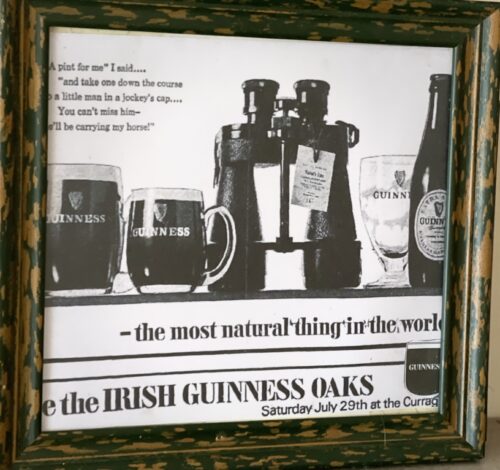
 38cm x 40cm Imagination is something Guinness Advertising has never been short of… From John Gilroy’s hapless zookeeper and his menagerie of creatures to a Polynesian surfer and a herd of white horses; from messages in bottles setting sail across the ocean to a single, heart-stoppingly enormous wave. Guinness have been carving out their own creative path for almost a century with decades of extraordinary and enduring print, TV and digital campaigns to their name, and hopefully they will continue to push boundaries to tell stories to the world. Here’s to original thinking !
38cm x 40cm Imagination is something Guinness Advertising has never been short of… From John Gilroy’s hapless zookeeper and his menagerie of creatures to a Polynesian surfer and a herd of white horses; from messages in bottles setting sail across the ocean to a single, heart-stoppingly enormous wave. Guinness have been carving out their own creative path for almost a century with decades of extraordinary and enduring print, TV and digital campaigns to their name, and hopefully they will continue to push boundaries to tell stories to the world. Here’s to original thinking ! -

 Great picture of a recuperating Arkle getting his lunch washed down by one of his two daily bottles of Guinness by the managing director of Kempton Park Racecourse Henry Hyde. Ratoath Co Meath. 45cm x 75cm Arkle (19 April 1957 – 31 May 1970) was an Irish Thoroughbred racehorse. A bay gelding by Archive out of Bright Cherry, he was the grandson of the unbeaten (in 14 races) flat racehorse and prepotent sire Nearco. Arkle was born at Ballymacoll Stud, County Meath, by Mrs Mary Alison Baker of Malahow House, near Naul, County Dublin. He was named after the mountain Arkle in Sutherland, Scotland that bordered the Duchess of Westminster’s Sutherland estate. Owned by Anne Grosvenor, Duchess of Westminster, he was trained by Tom Dreaper at Greenogue, Kilsallaghan in County Meath, Ireland, and ridden during his steeplechasing career by Pat Taaffe. At 212, his Timeform rating is the highest ever awarded to a steeplechaser. Only Flyingbolt, also trained by Dreaper, had a rating anywhere near his at 210. Next on their ratings are Sprinter Sacre on 192 and then Kauto Star and Mill House on 191. Despite his career being cut short by injury, Arkle won three Cheltenham Gold Cups, the Blue Riband of steeplechasing, and a host of other top prizes. On 19th April, 2014 a magnificent 1.1 scale bronze statue was unveiled in Ashbourne, County Meath in commemoration of Arkle.In the 1964 Cheltenham Gold Cup, Arkle beat Mill House (who had won the race the previous year) by five lengths to claim his first Gold Cup at odds of 7/4. It was the last time he did not start as the favourite for a race. Only two other horses entered the Gold Cup that year. The racing authorities in Ireland took the unprecedented step in the Irish Grand National of devising two weight systems — one to be used when Arkle was running and one when he was not. Arkle won the 1964 race by only one length, but he carried two and half stones more than his rivals. The following year's Gold Cup saw Arkle beat Mill House by twenty lengths at odds of 3/10. In the 1966 renewal, he was the shortest-priced favourite in history to win the Gold Cup, starting at odds of 1/10. He won the race by thirty lengths despite a mistake early in the race where he ploughed through a fence. However, it did not stop his momentum, nor did he ever look like falling. Arkle had a strange quirk in that he crossed his forelegs when jumping a fence. He went through the season 1965/66 unbeaten in five races. Arkle won 27 of his 35 starts and won at distances from 1m 6f up to 3m 5f. Legendary Racing commentator Peter O'Sullevan has called Arkle a freak of nature — something unlikely to be seen again. Besides winning three consecutive Cheltenham Gold Cups (1964, 1965, 1966) and the 1965 King George VI Chase, Arkle triumphed in a number of other important handicap chases, including the 1964 Irish Grand National (under 12-0), the 1964 and 1965 Hennessy Gold Cups (both times under 12-7), the 1965 Gallagher Gold Cup (conceding 16 lb to Mill House while breaking the course record by 17 seconds), and the 1965 Whitbread Gold Cup(under 12-7). In the 1966 Hennessy, he failed by only half a length to give Stalbridge Colonist 35 lb. The scale of the task Arkle faced is shown by the winner coming second and third in the two following Cheltenham Gold Cups, while in third place was the future 1969 Gold Cup winner, What A Myth. In December 1966, Arkle raced in the King George VI Chase at Kempton Park but struck the guard rail with a hoof when jumping the open ditch, which resulted in a fractured pedal bone; despite this injury, he completed the race and finished second. He was in plaster for four months and, though he made a good enough recovery to go back into training, he never ran again. He was retired and ridden as a hack by his owner and then succumbed to what has been variously described as advanced arthritis or possibly brucellosis and was put down at the early age of 13. Arkle became a national legend in Ireland. His strength was jokingly claimed to come from drinking 2 pints of Guinness a day. At one point, the slogan Arkle for President was written on a wall in Dublin. The horse was often referred to simply as "Himself", and he supposedly received items of fan mail addressed to 'Himself, Ireland'. The Irish government-owned Irish National Stud, at Tully, Kildare, Co. Kildare, Ireland, has the skeleton of Arkle on display in its museum. A statue in his memory was erected in Ashbourne Co Meath in 2004. Dimensions : 55cm x 60cm
Great picture of a recuperating Arkle getting his lunch washed down by one of his two daily bottles of Guinness by the managing director of Kempton Park Racecourse Henry Hyde. Ratoath Co Meath. 45cm x 75cm Arkle (19 April 1957 – 31 May 1970) was an Irish Thoroughbred racehorse. A bay gelding by Archive out of Bright Cherry, he was the grandson of the unbeaten (in 14 races) flat racehorse and prepotent sire Nearco. Arkle was born at Ballymacoll Stud, County Meath, by Mrs Mary Alison Baker of Malahow House, near Naul, County Dublin. He was named after the mountain Arkle in Sutherland, Scotland that bordered the Duchess of Westminster’s Sutherland estate. Owned by Anne Grosvenor, Duchess of Westminster, he was trained by Tom Dreaper at Greenogue, Kilsallaghan in County Meath, Ireland, and ridden during his steeplechasing career by Pat Taaffe. At 212, his Timeform rating is the highest ever awarded to a steeplechaser. Only Flyingbolt, also trained by Dreaper, had a rating anywhere near his at 210. Next on their ratings are Sprinter Sacre on 192 and then Kauto Star and Mill House on 191. Despite his career being cut short by injury, Arkle won three Cheltenham Gold Cups, the Blue Riband of steeplechasing, and a host of other top prizes. On 19th April, 2014 a magnificent 1.1 scale bronze statue was unveiled in Ashbourne, County Meath in commemoration of Arkle.In the 1964 Cheltenham Gold Cup, Arkle beat Mill House (who had won the race the previous year) by five lengths to claim his first Gold Cup at odds of 7/4. It was the last time he did not start as the favourite for a race. Only two other horses entered the Gold Cup that year. The racing authorities in Ireland took the unprecedented step in the Irish Grand National of devising two weight systems — one to be used when Arkle was running and one when he was not. Arkle won the 1964 race by only one length, but he carried two and half stones more than his rivals. The following year's Gold Cup saw Arkle beat Mill House by twenty lengths at odds of 3/10. In the 1966 renewal, he was the shortest-priced favourite in history to win the Gold Cup, starting at odds of 1/10. He won the race by thirty lengths despite a mistake early in the race where he ploughed through a fence. However, it did not stop his momentum, nor did he ever look like falling. Arkle had a strange quirk in that he crossed his forelegs when jumping a fence. He went through the season 1965/66 unbeaten in five races. Arkle won 27 of his 35 starts and won at distances from 1m 6f up to 3m 5f. Legendary Racing commentator Peter O'Sullevan has called Arkle a freak of nature — something unlikely to be seen again. Besides winning three consecutive Cheltenham Gold Cups (1964, 1965, 1966) and the 1965 King George VI Chase, Arkle triumphed in a number of other important handicap chases, including the 1964 Irish Grand National (under 12-0), the 1964 and 1965 Hennessy Gold Cups (both times under 12-7), the 1965 Gallagher Gold Cup (conceding 16 lb to Mill House while breaking the course record by 17 seconds), and the 1965 Whitbread Gold Cup(under 12-7). In the 1966 Hennessy, he failed by only half a length to give Stalbridge Colonist 35 lb. The scale of the task Arkle faced is shown by the winner coming second and third in the two following Cheltenham Gold Cups, while in third place was the future 1969 Gold Cup winner, What A Myth. In December 1966, Arkle raced in the King George VI Chase at Kempton Park but struck the guard rail with a hoof when jumping the open ditch, which resulted in a fractured pedal bone; despite this injury, he completed the race and finished second. He was in plaster for four months and, though he made a good enough recovery to go back into training, he never ran again. He was retired and ridden as a hack by his owner and then succumbed to what has been variously described as advanced arthritis or possibly brucellosis and was put down at the early age of 13. Arkle became a national legend in Ireland. His strength was jokingly claimed to come from drinking 2 pints of Guinness a day. At one point, the slogan Arkle for President was written on a wall in Dublin. The horse was often referred to simply as "Himself", and he supposedly received items of fan mail addressed to 'Himself, Ireland'. The Irish government-owned Irish National Stud, at Tully, Kildare, Co. Kildare, Ireland, has the skeleton of Arkle on display in its museum. A statue in his memory was erected in Ashbourne Co Meath in 2004. Dimensions : 55cm x 60cm -

 30cm x 36cm Imagination is something Guinness Advertising has never been short of… From John Gilroy’s hapless zookeeper and his menagerie of creatures to a Polynesian surfer and a herd of white horses; from messages in bottles setting sail across the ocean to a single, heart-stoppingly enormous wave. Guinness have been carving out their own creative path for almost a century with decades of extraordinary and enduring print, TV and digital campaigns to their name, and hopefully they will continue to push boundaries to tell stories to the world. Here’s to original thinking !
30cm x 36cm Imagination is something Guinness Advertising has never been short of… From John Gilroy’s hapless zookeeper and his menagerie of creatures to a Polynesian surfer and a herd of white horses; from messages in bottles setting sail across the ocean to a single, heart-stoppingly enormous wave. Guinness have been carving out their own creative path for almost a century with decades of extraordinary and enduring print, TV and digital campaigns to their name, and hopefully they will continue to push boundaries to tell stories to the world. Here’s to original thinking ! -

 50cm x 65cm Imagination is something Guinness Advertising has never been short of… From John Gilroy’s hapless zookeeper and his menagerie of creatures to a Polynesian surfer and a herd of white horses; from messages in bottles setting sail across the ocean to a single, heart-stoppingly enormous wave. Guinness have been carving out their own creative path for almost a century with decades of extraordinary and enduring print, TV and digital campaigns to their name, and hopefully they will continue to push boundaries to tell stories to the world. Here’s to original thinking !
50cm x 65cm Imagination is something Guinness Advertising has never been short of… From John Gilroy’s hapless zookeeper and his menagerie of creatures to a Polynesian surfer and a herd of white horses; from messages in bottles setting sail across the ocean to a single, heart-stoppingly enormous wave. Guinness have been carving out their own creative path for almost a century with decades of extraordinary and enduring print, TV and digital campaigns to their name, and hopefully they will continue to push boundaries to tell stories to the world. Here’s to original thinking ! -
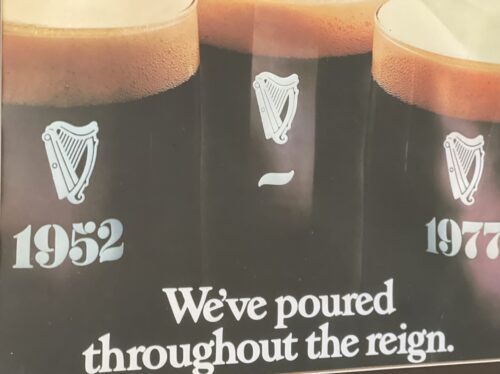
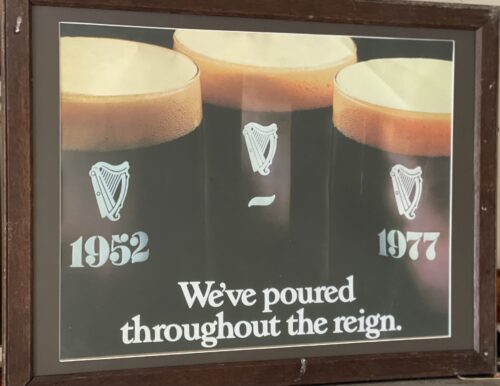 55cm x 70cm Imagination is something Guinness Advertising has never been short of… From John Gilroy’s hapless zookeeper and his menagerie of creatures to a Polynesian surfer and a herd of white horses; from messages in bottles setting sail across the ocean to a single, heart-stoppingly enormous wave. Guinness have been carving out their own creative path for almost a century with decades of extraordinary and enduring print, TV and digital campaigns to their name, and hopefully they will continue to push boundaries to tell stories to the world. Here’s to original thinking !
55cm x 70cm Imagination is something Guinness Advertising has never been short of… From John Gilroy’s hapless zookeeper and his menagerie of creatures to a Polynesian surfer and a herd of white horses; from messages in bottles setting sail across the ocean to a single, heart-stoppingly enormous wave. Guinness have been carving out their own creative path for almost a century with decades of extraordinary and enduring print, TV and digital campaigns to their name, and hopefully they will continue to push boundaries to tell stories to the world. Here’s to original thinking ! -

 50cm x 65cm Imagination is something Guinness Advertising has never been short of… From John Gilroy’s hapless zookeeper and his menagerie of creatures to a Polynesian surfer and a herd of white horses; from messages in bottles setting sail across the ocean to a single, heart-stoppingly enormous wave. Guinness have been carving out their own creative path for almost a century with decades of extraordinary and enduring print, TV and digital campaigns to their name, and hopefully they will continue to push boundaries to tell stories to the world. Here’s to original thinking !
50cm x 65cm Imagination is something Guinness Advertising has never been short of… From John Gilroy’s hapless zookeeper and his menagerie of creatures to a Polynesian surfer and a herd of white horses; from messages in bottles setting sail across the ocean to a single, heart-stoppingly enormous wave. Guinness have been carving out their own creative path for almost a century with decades of extraordinary and enduring print, TV and digital campaigns to their name, and hopefully they will continue to push boundaries to tell stories to the world. Here’s to original thinking ! -
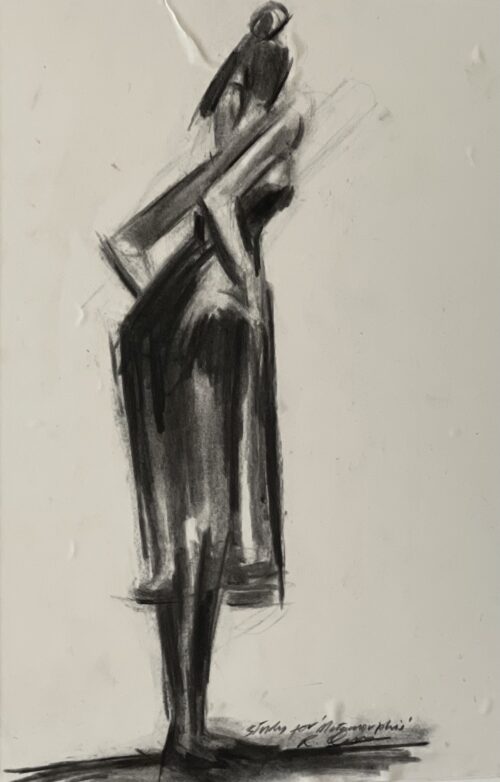
 45cm x 60cm Naas Co Kildare Extremely unusual charcoal sketch "Study for Metamorphosis"from the internationally renowned sculptor Bob Quinn.Quinn works from preparatory sketches like the beautiful charcoal featured here to the wax or clay original.He then makes his own moulds before taking the wax through the long casting procedure to the patination process and to the permanence of the final sculpture. Please email us directly at irishpubemporium@gmail.com for more information. BOB QUINN grew up with sculpture. His father, a bank manager, was a part-time artist and, as a boy, Bob would watch him casting and moulding sculptures for sale. Bob dabbled for years too, producing the odd private commission but it was only after a long career in commercial art and design that he took the "frankly terrifying" step of giving up his job as a commercial designer BOB QUINN grew up with sculpture. His father, a bank manager, was a part-time artist and, as a boy, Bob would watch him casting and moulding sculptures for sale. Bob dabbled for years too, producing the odd private commission but it was only after a long career in commercial art and design that he took the "frankly terrifying" step of giving up his job as a commercial designer to become a full-time sculptor. His first major exhibition, at the Solomon Gallery in the Powerscourt Centre, Dublin, is the culmination of months of hard work. Seeking inspiration in everyday life, Bob first sketches his tableaux of human interaction in charcoals before moulding the figures in clay and finally casting them in bronze. The pieces are full of quiet drama. In the ironically titled Conspiracy, two womencasually gossip on a bench while a third listens in.Without overburdening each figure with facial detail,Bob lets the weight of the bodies and the angles of the glances between them convey their various personalities. Quinn lists Epstein and Rodin amongst his inspirations but his sculpture Waiting recalls the stark memorial pieces of German sculptor Kathe Kollwitz. We see the lonely figure of a man grieving on the rugged western shoreline. His hand pulls the coat around his face shielding him from the elements, but also to hide his grief. The figures are largely naturalistic, but Quinn is not over-preoccupied with a rigidly-correct anatomy. In many pieces, such as The Christmas Swim the enlarged hands and feet exaggerate the gestures giving the figures an almost playful expression. Quinn's works are being displayed in an exhibition of work from various artists at the Solomon Gallery until July 21.Born in 1948 Bob Quinn enjoyed a long career within the Irish advertising business as a commercial artist, designer and as the head of a successful design and production company. He now works full time as a sculptor in Blackrock Co Dublin where he lives with his wife and two daughters.
45cm x 60cm Naas Co Kildare Extremely unusual charcoal sketch "Study for Metamorphosis"from the internationally renowned sculptor Bob Quinn.Quinn works from preparatory sketches like the beautiful charcoal featured here to the wax or clay original.He then makes his own moulds before taking the wax through the long casting procedure to the patination process and to the permanence of the final sculpture. Please email us directly at irishpubemporium@gmail.com for more information. BOB QUINN grew up with sculpture. His father, a bank manager, was a part-time artist and, as a boy, Bob would watch him casting and moulding sculptures for sale. Bob dabbled for years too, producing the odd private commission but it was only after a long career in commercial art and design that he took the "frankly terrifying" step of giving up his job as a commercial designer BOB QUINN grew up with sculpture. His father, a bank manager, was a part-time artist and, as a boy, Bob would watch him casting and moulding sculptures for sale. Bob dabbled for years too, producing the odd private commission but it was only after a long career in commercial art and design that he took the "frankly terrifying" step of giving up his job as a commercial designer to become a full-time sculptor. His first major exhibition, at the Solomon Gallery in the Powerscourt Centre, Dublin, is the culmination of months of hard work. Seeking inspiration in everyday life, Bob first sketches his tableaux of human interaction in charcoals before moulding the figures in clay and finally casting them in bronze. The pieces are full of quiet drama. In the ironically titled Conspiracy, two womencasually gossip on a bench while a third listens in.Without overburdening each figure with facial detail,Bob lets the weight of the bodies and the angles of the glances between them convey their various personalities. Quinn lists Epstein and Rodin amongst his inspirations but his sculpture Waiting recalls the stark memorial pieces of German sculptor Kathe Kollwitz. We see the lonely figure of a man grieving on the rugged western shoreline. His hand pulls the coat around his face shielding him from the elements, but also to hide his grief. The figures are largely naturalistic, but Quinn is not over-preoccupied with a rigidly-correct anatomy. In many pieces, such as The Christmas Swim the enlarged hands and feet exaggerate the gestures giving the figures an almost playful expression. Quinn's works are being displayed in an exhibition of work from various artists at the Solomon Gallery until July 21.Born in 1948 Bob Quinn enjoyed a long career within the Irish advertising business as a commercial artist, designer and as the head of a successful design and production company. He now works full time as a sculptor in Blackrock Co Dublin where he lives with his wife and two daughters.He has pursued his love of drawing and sculpture throughout his career and has illustrated several publications and has been a regular contributor of illustrations to Independent Newspapers. His sculptures appear in private collections and gardens throughout Ireland, Britain and Europe.
Although loosely described as figurative his art is expressionist and his deep knowledge of anatomy allows him to abstract the human form and make the simplest of observations. His lifelong influences have been Epstein, Marini and Giacometti and painters such as Millet and Degas. His current work is a celebration of the drama and the nobility of the most ordinary of human activity. In terms of the craft of sculpture he enjoys the whole time worn process: Working from preparatory sketches to the wax or clay original he then makes his own moulds before taking the wax through the long casting procedure to the patination process and to the permanence of the final sculpture.
-

 35cm x 40cmEFORE THE ADVENT of opinion polls, by-elections were the most reliable means of gauging the mood of the electorate.For decades before the 1916 Rising, Irish nationalists represented by the Irish Parliamentary Party (IPP) sought Irish home rule – a subordinate parliament and government in Dublin.But the emergence of Sinn Féin, which championed an independent Irish republic, transformed the political landscape. In 1917 Sinn Féin won four by-elections on the bounce in North Roscommon, South Longford, East Clare and South Kilkenny.No victory was more emphatic than East Clare and no winning candidate more central to the future history of Ireland.A political noviceThe victor was a political novice with little experience of public speaking outside the classroom. The senior surviving Volunteer from 1916, he was largely unknown before the East Clare by-election.But after it he was catapulted to national prominence, became president of Sinn Féin and represented East Clare for the next four decades. That soldier turned politician was De Valera .The East Clare by-election on July 10 was precipitated by the death on the Western Front of the sitting MP: Major Willie Redmond, brother of the leader of the IPP.Patrick Lynch KC, a barrister, contested the seat for the IPP under the banner: “Clare for a Clareman – Lynch is the Man”. His supporters, who were strongest in Ennis, contended that an Irish republic was a political fantasy. For several reasons, few expected anything other than a Sinn Féin victory.One of the most rebellious counties in IrelandFirst, Clare was one of the most rebellious counties in Ireland and during the by-election the county inspector of the Royal Irish Constabulary had to obtain a draft of 150 soldiers. Eight months after the by-election Clare became the first county to be placed under military rule since the 1916 Rising.Second, no election had been contested in East Clare since 1895 and the IPP’s constituency machine was decrepit and almost bankrupt. By contrast, the Sinn Féin campaign was highly organised and backboned by the revamped Irish Volunteers who were unafraid to defy the authorities and acted as a private police force.De Valera, who had only been released from prison on 16 June, campaigned in his Volunteer uniform and told the electors that, “every vote you give now is as good as the crack of a rifle in proclaiming your desire for freedom”.Third, buoyed up by its earlier electoral successes Sinn Féin attracted not just the support of the young but that of the Clare Champion (the county newspaper) and, more significantly, the endorsement of Bishop Michael Fogarty of Killaloe and the majority of younger clergy. The Catholic card was played astutely and reassuringly by de Valera.Although everyone expected a victory for de Valera, no one expected so stunning a winning margin. When the result of the election was announced on July 11 de Valera had secured 5,010 votes to Lynch’s 2,035.A game changerThe rural vote had turned against the IPP. The Freeman’s Journal, the newspaper of the IPP, lamented that, “East Clare has declared for revolution by an overwhelming majority”. Lynch was not the man after all.The East Clare by-election was a milestone for Sinn Féin because it secured a striking popular mandate which helped the organisation to continue its rapid growth ahead of the 1918 general election.For de Valera his victory was a pivotal episode in his progression from militant to political republican. More than any other factor, the scale of his success propelled him to the presidency of Sinn Féin in October 1917 and launched his long political career. For a man who in the early months of 1917 wished to have no truck with politics this was quite a turn of events.
35cm x 40cmEFORE THE ADVENT of opinion polls, by-elections were the most reliable means of gauging the mood of the electorate.For decades before the 1916 Rising, Irish nationalists represented by the Irish Parliamentary Party (IPP) sought Irish home rule – a subordinate parliament and government in Dublin.But the emergence of Sinn Féin, which championed an independent Irish republic, transformed the political landscape. In 1917 Sinn Féin won four by-elections on the bounce in North Roscommon, South Longford, East Clare and South Kilkenny.No victory was more emphatic than East Clare and no winning candidate more central to the future history of Ireland.A political noviceThe victor was a political novice with little experience of public speaking outside the classroom. The senior surviving Volunteer from 1916, he was largely unknown before the East Clare by-election.But after it he was catapulted to national prominence, became president of Sinn Féin and represented East Clare for the next four decades. That soldier turned politician was De Valera .The East Clare by-election on July 10 was precipitated by the death on the Western Front of the sitting MP: Major Willie Redmond, brother of the leader of the IPP.Patrick Lynch KC, a barrister, contested the seat for the IPP under the banner: “Clare for a Clareman – Lynch is the Man”. His supporters, who were strongest in Ennis, contended that an Irish republic was a political fantasy. For several reasons, few expected anything other than a Sinn Féin victory.One of the most rebellious counties in IrelandFirst, Clare was one of the most rebellious counties in Ireland and during the by-election the county inspector of the Royal Irish Constabulary had to obtain a draft of 150 soldiers. Eight months after the by-election Clare became the first county to be placed under military rule since the 1916 Rising.Second, no election had been contested in East Clare since 1895 and the IPP’s constituency machine was decrepit and almost bankrupt. By contrast, the Sinn Féin campaign was highly organised and backboned by the revamped Irish Volunteers who were unafraid to defy the authorities and acted as a private police force.De Valera, who had only been released from prison on 16 June, campaigned in his Volunteer uniform and told the electors that, “every vote you give now is as good as the crack of a rifle in proclaiming your desire for freedom”.Third, buoyed up by its earlier electoral successes Sinn Féin attracted not just the support of the young but that of the Clare Champion (the county newspaper) and, more significantly, the endorsement of Bishop Michael Fogarty of Killaloe and the majority of younger clergy. The Catholic card was played astutely and reassuringly by de Valera.Although everyone expected a victory for de Valera, no one expected so stunning a winning margin. When the result of the election was announced on July 11 de Valera had secured 5,010 votes to Lynch’s 2,035.A game changerThe rural vote had turned against the IPP. The Freeman’s Journal, the newspaper of the IPP, lamented that, “East Clare has declared for revolution by an overwhelming majority”. Lynch was not the man after all.The East Clare by-election was a milestone for Sinn Féin because it secured a striking popular mandate which helped the organisation to continue its rapid growth ahead of the 1918 general election.For de Valera his victory was a pivotal episode in his progression from militant to political republican. More than any other factor, the scale of his success propelled him to the presidency of Sinn Féin in October 1917 and launched his long political career. For a man who in the early months of 1917 wished to have no truck with politics this was quite a turn of events.

